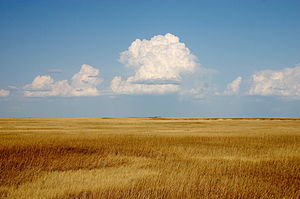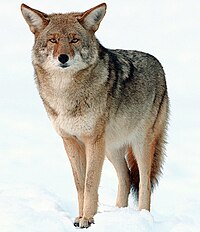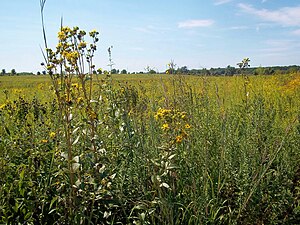
Hi Everybody!!
I had the opportunity to ride along on a road trip with my friend Linda and her crew out to a client's place on the Prairie. Heading toward the Belleville Area is only about 45 minutes away from Rainbow Creek, but everything is different. Different plants, different birds, wide open spaces and big, big sky. There are scattered woods connected by big treeless fields. While the landscaping crew worked in the gardens, I took off on an adventure to find some of these different birds. I could hear birds everywhere, but could not see them. I scanned the big trees and saw nothing. I glanced out across the meadow and still, nothing. Then I saw something move in the grass and then many somethings moving in the grass. One popped his head up-It is a Meadowlark! They were everywhere in plain sight. You will see their camouflage in the pics shared below with the links to the photostudies. Of course, I have shared info from Wikipedia on Prairie and the birds. One bonus sighting: a Coyote (prairie wolf). Come enjoy the trip to the Prairie via my pics!
https://en.wikipedia.org/wiki/Prairie
Prairie
From Wikipedia, the free encyclopedia

Prairie, Badlands National Park, South Dakota, USA, is in the mixed grasslands region containing some species of tall grass and some of short grass
Formation[edit]
The formation of the North American Prairies started with the upwelling of theRocky Mountains. The mountains created a rain shadow that killed most of the trees.[citation needed]
The parent material of most prairie soil was deposited during the last glacial advance that began about 110,000 years ago. The glaciers expanding southward scraped the landscape, picking up geologic material and leveling the terrain. As the glaciers retreated about 10,000 years ago, it deposited this material in the form of till. Wind based loess deposits also form an important parent material for prairie soils.[2]
Tallgrass Prairie evolved over tens of thousands of years with the disturbances of grazing and fire. Native ungulates such as bison, elk, andwhite-tailed deer, roamed the expansive, diverse, plentiful grassland beforeEuropean colonization of the Americas.[3] For 10,000-20,000 years native people used fire annually as a tool to assist in hunting, transportation and safety.[4] Evidence of ignition sources of fire in the tallgrass prairie are overwhelmingly human as opposed to lightning.[5] Humans, and grazing animals, were active participants in the process of prairie formation and the establishment of the diversity of graminoid and forbs species. Fire has the effect on prairies of removing trees, clearing dead plant matter, and changing the availability of certain nutrients in the soil from the ash produced. Fire kills the vascular tissue of trees, but not prairie, as up to 75% (depending on the species) of the total plant biomass is below the soil surface and will re-grow from its deep (up to 6 feet) roots. Without disturbance, trees will encroach on a grassland, cast shade, which suppresses the understory. Prairie and widely spaced oak trees evolved to coexist in the oak savanna ecosystem.[6]
Fertility[edit]
In spite of long recurrent droughts and occasional torrential rains, the grasslands of the Great Plains were not subject to great soilerosion. The root systems of native prairie grasses firmly held the soil in place to prevent run-off of soil. When the plant died, the fungi,bacteria returned its nutrients to the soil.
These deep roots also helped native prairie plants reach water in even the driest conditions. The native grasses suffered much less damage from dry conditions than the farm crops currently grown.
Types[edit]
Prairie in North America is usually split into three groups: wet, mesic, and dry.[7] They are generally characterized by tallgrass prairie, mixed, orshortgrass prairie, depending on the quality of soil and rainfall.
Wet[edit]
In wet prairie, the soil is usually very moist most of the growing season and has poor water drainage. This can possibly contain a bog or fen, since it often has plentiful stagnant water. This type of prairie has the best type of farming soil. The average precipitation amount is 10- 30 inches a year.
Mesic[edit]
Mesic prairie /ˈmiːzɪk/ has good drainage, but good soil during the growing season. This type of prairie is the most often converted for agricultural usage, consequently it is one of the more endangered types of prairie.
Dry[edit]
Dry prairie has somewhat wet to very dry soil during the growing season because of good drainage in the soil. Often, this prairie can be found on uplands or slopes. Dry soil usually doesn't get much vegetation due to lack of rain.
Please see link for complete articleYou can get more info about the prairie in Texas from Google Search (example below)
Katy Prairie Conservancy | Preserves
www.katyprairie.org/preserves.html
The Katy Prairie Conservancy (KPC) owns and manages 14 preserves. Together these preserves cover more than 13,000 acres of habitat just west of Houston, ...

https://en.wikipedia.org/wiki/Meadowlark
This genus includes seven species of largely insectivorous grassland birds. In all species the male at least has a black or brown back and extensively red or yellow underparts.
Meadowlark
From Wikipedia, the free encyclopedia
| Meadowlarks | |
|---|---|
 | |
| Eastern Meadowlark | |
| Scientific classification | |
| Kingdom: | Animalia |
| Phylum: | Chordata |
| Class: | Aves |
| Order: | Passeriformes |
| Family: | Icteridae |
| Genus: | Sturnella Vieillot, 1816 |

Clips created by Auto BackUp. (In your settings button on G+)







link to album photostudy:
https://plus.google.com/u/0/photos/117645114459863049265/albums/5962708942427128145


https://en.wikipedia.org/wiki/Coyote
Coyote
From Wikipedia, the free encyclopedia
The coyote (US /kaɪˈoʊtiː/ or /ˈkaɪ.oʊt/, UK /kɔɪˈjoʊteɪ/, or /kɔɪˈjoʊt/;[2] Canis latrans), also known as the American jackal, brush wolf, or the prairie wolf, is a species of caninefound throughout North and Central America, ranging from Panama in the south, north through Mexico, the United States, and Canada. It occurs as far north as Alaska and all but the northernmost portions of Canada.[3] The term is also used for the eastern coyote(Canis latrans var.), which contains not only C. latrans but also significant percentages ofCanis lupus lycaon ancestry.[4]
Currently, 19 subspecies are recognized, with 16 in Canada, Mexico, and the United States, and three in Central America.[5] Unlike the related gray wolf, which is Eurasian in origin, evolutionary theory suggests the coyote evolved in North America during thePleistocene epoch 1.8 million years ago (mya),[6] alongside the dire wolf.[7] Although not closely related, the coyote evolved separately to fill roughly the same ecological niche in the Americas that is filled in Eurasia and Africa by the similarly sized jackals. Unlike the wolf, the coyote's range has expanded in the wake of human civilization, and coyotes readily reproduce in metropolitan areas.[8][9]
| Coyote | |
|---|---|
 | |
| From Yosemite National Park | |
| Conservation status | |
| Scientific classification | |
| Kingdom: | Animalia |
| Phylum: | Chordata |
| Class: | Mammalia |
| Infraclass: | Eutheria |
| Order: | Carnivora |
| Family: | Canidae |
| Genus: | Canis |
| Species: | C. latrans |

link to album photostudy:
https://plus.google.com/u/0/photos/117645114459863049265/albums/5962714618882919361

...this is brendasue signing off from Rainbow Creek. See You next time (back in the woods)!

O+O




No comments:
Post a Comment
Hi Everybody! Please say hello and follow so I know you are here! Due to the inconsideration of people trying to put commercials on my blog comment area, I have restricted use of anonymous posts. Sorry that some hurt all.
My public email is katescabin@gmail.com No spammers or trolls